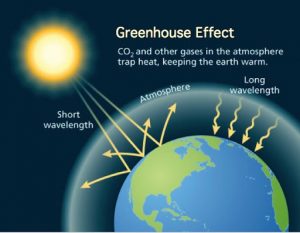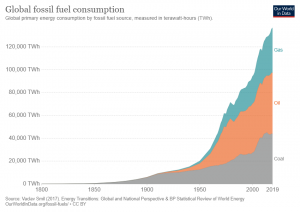Since the 1880’s fossil fuels have been the primary source of energy used by humans for the creation of heat, work and electricity.
Fossil fuels exist in three main forms:
In recent years, however, it has become apparent that fossil fuels are not a sustainable primary source of energy in the long-term. These fuels are considered “non-renewable” as they must spend millions of years being formed in the Earth’s crust before being available in the forms described above. Moreover, the combustion of fossil fuels results in the emission of gaseous by-products known as greenhouse gases. These greenhouse gases modify the composition of the Earth’s atmosphere giving rise to a “greenhouse” effect, from which they derive their name. Radiation from the sun warms and is reflected off the Earth’s surface, and heat is then trapped by this insulating layer of gas, subsequently resulting in rising temperatures (See Figure). This phenomenon is known as global warming.
%27%20fill-opacity%3D%27.5%27%3E%3Cellipse%20fill%3D%22%2375c6e3%22%20fill-opacity%3D%22.5%22%20rx%3D%221%22%20ry%3D%221%22%20transform%3D%22matrix(100.95889%2048.3714%20-38.20181%2079.73333%20255%20259.9)%22%2F%3E%3Cellipse%20fill%3D%22%23050400%22%20fill-opacity%3D%22.5%22%20rx%3D%221%22%20ry%3D%221%22%20transform%3D%22matrix(-202.29342%20-32.05969%208.78026%20-55.40258%20318.6%2042.4)%22%2F%3E%3Cellipse%20fill%3D%22%23002000%22%20fill-opacity%3D%22.5%22%20rx%3D%221%22%20ry%3D%221%22%20transform%3D%22matrix(-33.4429%20-100.9848%2070.38008%20-23.3076%2027.6%20222.6)%22%2F%3E%3Cellipse%20fill%3D%22%239e737a%22%20fill-opacity%3D%22.5%22%20rx%3D%221%22%20ry%3D%221%22%20transform%3D%22matrix(-50.78118%20-10.60874%209.5501%20-45.71377%2068%2066.4)%22%2F%3E%3C%2Fg%3E%3C%2Fsvg%3E)
Figure 1 – Greenhouse Effect
Towards the end of the 20th century, the threat imposed by rising temperatures and the associated climate change was identified and since then has had a growing profile internationally. This represented a truly global dilemma, which must in turn be addressed on a global scale. In 2016, the world saw the first united approach to combatting global warming with 196 countries signing the Paris Agreement. This international treaty sought to enact measures seeing a move towards a global “carbon net zero”. Carbon net zero refers to balancing the amount of emitted greenhouse gases with an equivalent mean that will offset or sequester the same amount. The goal of the initiative is to work towards remedying the current worldwide energy practices which have given rise to the unprecedented global warming and climate changes witnessed over the preceding decades. The Paris Agreement sets a long-term temperature goal of limiting the rise of global temperatures to well below 2 degrees Celsius.
The demand for fossil fuels has exponentially increased to subsist constantly rising human productivity (See figure). However as previously explored this is not sustainable in the long-term and a simple solution to this is to reduce unnecessary demand for fossil fuels by implementing Energy Conservation. This can be defined as the process of achieving the same work output utilizing methods that require less energy.
%27%20fill-opacity%3D%27.5%27%3E%3Cellipse%20fill%3D%22%23c6c6c6%22%20fill-opacity%3D%22.5%22%20rx%3D%221%22%20ry%3D%221%22%20transform%3D%22matrix(-143.84237%20226.22486%20-66.54483%20-42.31173%20316.7%20185.7)%22%2F%3E%3Cellipse%20fill%3D%22%23aba9a9%22%20fill-opacity%3D%22.5%22%20rx%3D%221%22%20ry%3D%221%22%20transform%3D%22matrix(-26.93845%20-15.67855%2025.1063%20-43.13696%20309.6%20185.1)%22%2F%3E%3Cellipse%20fill%3D%22%23fff%22%20fill-opacity%3D%22.5%22%20rx%3D%221%22%20ry%3D%221%22%20transform%3D%22matrix(-227.52198%20257.15054%20-103.48518%20-91.56175%20102.4%20108.7)%22%2F%3E%3Cpath%20fill%3D%22%23fff%22%20fill-opacity%3D%22.5%22%20d%3D%22M-126.4%20260.8L39.8-95.8%20291.5%2021.6%20125.3%20378.2z%22%2F%3E%3C%2Fg%3E%3C%2Fsvg%3E)
Figure 2 – Global Fossil Fuel Consumption
In 2016, the world saw the first united approach to combatting global warming with 196 countries signing the Paris Agreement. This international treaty sought to enact measures seeking a move towards a global “carbon net zero” state by controlling the emission of greenhouse gases.
Carbon net zero refers to balancing the amount of emitted greenhouse gases with an equivalent amount through reduction or sequestration that will result in a net zero emission. The goal of the carbon net zero initiative is to work towards modifying the current worldwide energy practices so that the emission of greenhouse gases is reduced below sequestration.
The Paris Agreement is based on a long-term temperature goal of limiting the rise of global temperatures to well below 2 degrees Celsius. Each country has agreed to specific reduction in greenhouse emission either through reduced use or sequestration of produced gases.



